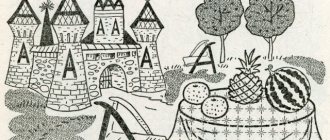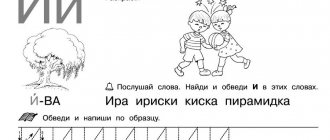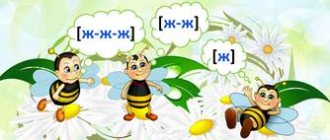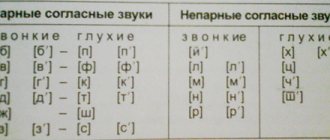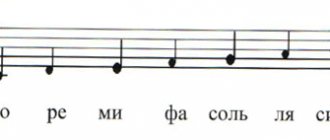History of the origin of the letter A
The Phoenicians were the first to use the letter A. Their alphabet began with “alef”.
It was written almost like our letter A. Only its position was lying to the left.
And the crossbar was a little closer to the top of the triangle.
This outline resembled a bull's head. The Phoenicians revered bulls as a holy animal.
The very sound that began the alphabet and was transmitted by this letter sounded like a guttural consonant.
And it was not a vowel at all among the Phoenicians.
In Cyrillic, the letter A was immediately written in the same way as we now write a small “a”. Look at the pictures.
Why is the letter A with pictures in front of the word better remembered?
For a child, letters are an abstraction, something incomprehensible. It is important that in addition to the letter itself, he also remembers the image - the picture. We all remember our first alphabet, there was a picture next to each letter. It’s even better if the child has a real-life example. For example, on our card there is the word Lampshade. Find it in your home and let your child look at it. You can literally touch and test “tooth” something edible starting with the letter A, for example, watermelon, apricot, pineapple, orange. You can smell the aster. Cars and buses surround city residents everywhere, and they drive on asphalt. Draw the letter A on the pavement with chalk while walking.
Actors and actresses star in films, acrobats and arena perform in circuses. Perhaps you have an aquarium in your house? Find a practical application for the abstract letter. Have your child paint with watercolors and note that the watercolor begins with A. Let him paint A with watercolors with your help or on his own, if he can. Such an experience will penetrate into the very depths of the child’s consciousness and his brain will absorb this important information about the first letter of the Russian alphabet, which also begins with A.
Does your child like to look at animals: the words stork and shark would be suitable. Modern houses on the street are full of antennas, draw your child’s attention to them and he will automatically remember the letter A when he sees the antenna. There are also many inscriptions around that contain the letter A, for example, Pharmacy. Or maybe your child likes to listen to music? Then draw his attention to musical instruments on A, for example, Harp, Viola. What methods do you use to easily memorize information?
Phonetic warm-up with sound A
A very useful exercise is to practice phonetics using special audio files. The recording is made using one single sound A in different configurations. This exercise helps control auditory perception.
For example, A AA AAA AAAA AAAAAAAAAAAAAAA AAAAAAAAAAA AAAAAAAAAAAAAA AAAAAAAAA A AA A AA AAA AAAA AAAAAAAAAAAAAA AAAAAAAAAAA AAAAAAAAAAAAAA A A AA A AA AAA AAAA AAAAAAAAAAAAAAA AAAAAAAAAAA AAAAAAAAAAAA AAAAAAAAA AA A AA A AA AAA AAAA AAAAAAAAAAAAAAAAAA AAAAAAAAA AAAAAAAAAAAA AAAAAAAAA A AA A AA AAA AAAA AAAAAAAAAAAAAAA AAAAAAAAAAA AAAAAAAAAAAA AAAAAAAAA AA A AA A AA AAA AAAA AAAAAAAAAAAAAAAAAA AAAAAAAAA AAAAAAAAAAA AAAAAAAAA A AA AAAAAAAA
Try repeating the following songs after the speaker.
Possible defects
- A=E (meme). Sometimes it happens that a child writes the alphabet, but cannot pronounce even such a simple sound [A]. Perhaps the back of his tongue is too elevated, and his mouth does not open enough, which is why the incisors are very close to each other.
- A=I. When working in front of a mirror, try to keep your tongue flat and not pull it inside your mouth. If the child is unable to do this, take a spatula and lightly press on the back of the tongue.
- A=Y (mymy) - deep sound. The tip of the tongue is pulled too much inward, the tongue folds into a lump. The correction is the same as for A=E. If it is difficult, then suggest bringing the tip of the tongue closer to the incisors and in this position try to pronounce [A].
- A=O. This defect is caused by improper lip position. Correction: only repeated imitation and articulation exercises.
- Open nasality appears when the velum is lowered. In this case, the voice is not involved, only the lips work. To eliminate such a violation, you must first explain what the child is doing wrong. Imitation and exercises for a firm attack will help (we speak abruptly, articulation is tense). The effect can be achieved using the conducting method. Then the palatal curtain will rise reflexively. We gradually move on to the drawn-out A, A, A....
Learning the letter A by playing - What does the letter A look like?
ATTENTION!
REGISTER FOR COURSES! RECRUITING! More details on the page: https://academy.multi-mama.ru/product/multi-predlozhenie/
It is important to arouse interest in the child and support him on the path of knowledge. Start learning letters as early as possible in a simple playful way. When you walk with your child, communicate, play with him, pay his attention to the letters. They surround us everywhere. Pay attention to what the letter A looks like. A stepladder, two logs and one more between them. Maybe some tree grows in the shape of a letter or something? Eiffel Tower?
It is important that the child has positive emotions while learning letters. He may be happy that mom or dad is telling him something important. Tell him how letters help people. What you can read yourself, determine what street you are on, find which cartoon to watch yourself.
Each person has several channels of information perception: auditory (hearing), visual (picture), kinesthetic (touch) and motor (scheme, algorithm). Special tests will help determine which channel of perception is more developed in each individual person. Whether this is genetically determined or formed depending on the environment surrounding the child is not yet clear. I agree with the opinion that a child can be helped to develop all channels of perception, so it is very important that he: - hears the letter; - saw an image - a picture; — touched it in the real world; - I drew it.
Sound production and automation [A]
Since the sound [A] is considered a mid-range lower rise, it has its own sound characteristics.
Articulation of isolated sound [A] is normal
When a person (of any age) does not have any speech defects or disorders, then while pronouncing the sound [A] (one, not in a syllable, not in a word, but simply A), the lips should be in a relaxed state, free.
They do not change their position in any way (passive).
The mouth is open.
The upper incisors are located 2 cm from the lower ones.
The tongue is also in a free position without movement at the very bottom of the oral cavity.
Only the tip of the tongue near the lower incisors, the back of the tongue in the lower elevation position.
The palate is slightly raised, the velum palatine is in contact with the back wall of the pharynx, closing the passage into the nasal cavity.
The sound [A] is oral.
The vocal cords close and the voice begins to vibrate, creating a vocal sound.
If you observe the process in the mirror, you can clearly see the position of the lips, the tips of the incisors, and you can see a little in what position the tongue is.
When pronouncing the sound [A], the mirror fogs up.
By placing your palm on the larynx, you can feel it vibrating. A slight vibration is also felt in the sternum area.
These are indicators of normal sound pronunciation [A].
Elimination of incorrect articulation A
If there are any violations, then it is necessary to begin work specifically to establish correct articulation.
The adult shows all the positions of the oral organs in the picture, on himself and controls the position of the students on their mirrors.
After the position of the organs is fixed, the following stages of work occur:
- Select a number of words in which the sound [A] is in the stressed position.
- Give an example of correct pronunciation. The learner must perceive the word, i.e. auditory-visual perception must be established. Visual and auditory visual aids are used.
- Make words by breaking them into syllables.
- Division into sounds, working with sound in isolation.
- Then phonetic gymnastics (rhythmics) is carried out - working with breathing, placing the tongue near the lower incisors, working with the voice.
How easy is it for a child to learn the letter A at 3-4 years old and at 5-6 years old?
A child has an absorbent mind. This is confirmed by Maria Montessori, who devoted her life to raising children. The period of special receptivity of a person to learning letters is from 0 to 6 years. However, the child must be ready to learn and tuned in to it. There are children who, as soon as they begin to speak, are already interested in letters, of course, if their parents invited them to study them and created positive reinforcement for this event, that is, they were extremely happy when the child first began to show interest in letters.
There is an opinion that initially a child must master physical training, learn to deftly control his body, that is, master climbing, crawling, walking on steps - develop gross motor skills, and also develop fine motor skills - movements with the tips of his fingers: modeling, drawing, fingering small objects. And only then can you teach letters. That is, by the age of 5-6 it will be normal.
From my personal experience, I believe that everything needs to be done simultaneously and in parallel, following the desire and interest of the child. That is, you can start learning letters and showing them when the child is not even a year old. At 3-4 years old, a child should normally already have a fairly large vocabulary and maintain a conversation. Perhaps this is the right period to start getting acquainted with letters?
Speech game "Ladder"
Goal: to teach to determine the place of the sound A in a word.
Equipment: drawn ladder and toy.
If two or more participants are playing, then toys are distributed to everyone, and more words are selected.
Progress of the game: words are called (for more players, prepare more words), and players must move the toys up a certain number of steps.
- If the sound A is at the beginning of a word, it goes up one step.
- In the middle there are two steps.
- At the end - up three steps.
- If there are two A sounds in a word, it goes up four steps.
The words are called out to each player in turn.
The winner is the one who named the position of the sound correctly in all words and rose the highest on the steps.
To ensure that everyone is on an equal footing, each player has his own set of words with the same A positions.
If the answer is given incorrectly to any word, then the toy moves down one step.
You can play for a long time until the players get tired and the host runs out of words.
You can make them up as you go.
Creating the letter A
The Phoenicians did not come up with the letter A themselves. They were a people of seafarers. They brought with them the best and most progressive things from all the countries they visited.
They even borrowed letters.
Previously, the inhabitants of the East marked every thought in the form of an icon. Short and clear. They liked the sign with outline A and was also included in the list of commonly used signs.
And since the letter was actually lying on its side, it could easily pass for a hieroglyph.
It was only later that the letter was turned over and put on its feet. In this form, it has reached our lands and the Cyrillic alphabets. To this day it is not known where the letter A came from.
But we are sure that if it had not once been borrowed by ancient sailors, then perhaps we would now use hieroglyphs as an alphabet, like all normal ancient Egyptian and Chinese people.
ABC fairy tale “Garage from the letter A”
“I want to introduce you to the letter A today, son.”
- I don’t want to learn letters, I don’t want to learn the alphabet, I want to play garage.
- But the letter A can also play with you. Just get to know her.
- I am the letter A. And I can become your garage.
- What kind of garage could it be? You're a letter.
- Look at me more closely. You can put your typewriter under my crossbar.
- Yes, and I’ll put the spare tire for my car on the crossbar.
- Of course you can. And you can hang a flashlight on the very tip so that there is light for your car in the garage.
- That's how wonderful we play. - said the letter A and smiled with its crossbar.
